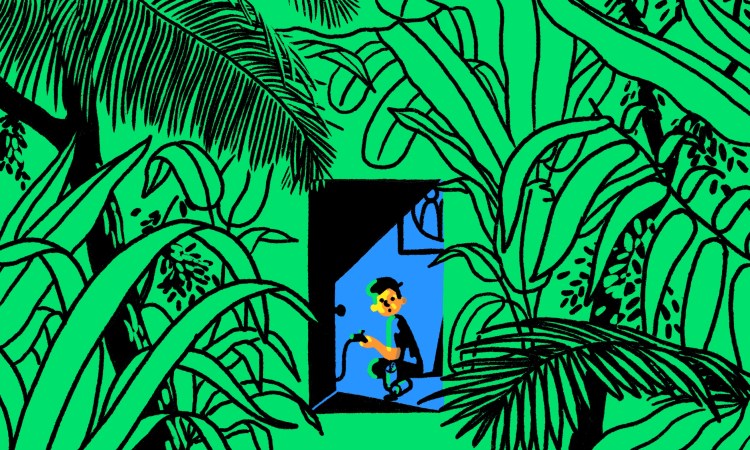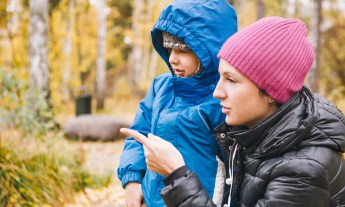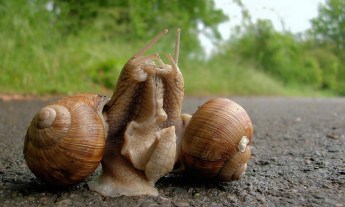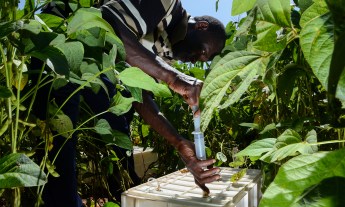
You don’t need to go to a national park to help your kids fall in love with nature; a walk around the block can be enough. Tech also doesn’t have to be the enemy. Instead, use it as a tool to enhance their awe, says science communicator Scott Sampson.
This post is part of TED’s “How to Be a Better Human” series, each of which contains a piece of helpful advice from someone in the TED community; browse through all the posts here.
Growing up, Scott Sampson — the paleontologist and CEO of Science World in Vancouver, Canada — went on annual camping trips to the Rocky Mountains with his family. However, “this was not where I fell in love with nature,” he recalls in a TEDxLangleyED talk. “That happened close to home — looking for rocks in the backyard, playing kick-the-can in the neighborhood, bushwhacking in the local forest.” Sampson, who grew up in Vancouver, says, “I still remember my mother kicking me outside on a Saturday and telling me to come back in when the street lights came on. I’m pretty sure I remember hearing the door lock behind me as I walked away.”
Even though he knows it’s not possible for today’s children to have that freedom, he encourages parents to help kids fall in love with nature just like he did: through direct experience. He recommends three steps that we — along with the children in our lives — can take to connect with nature.
Step #1: Notice
We don’t need to invest in outdoor equipment or an expensive vacation to get started, according to Sampson, also the author of How to Raise A Wild Child. We just need to notice what’s around us, even if we live in a city. “Too often these days, we walk right past amazing natural events,” he says. “It could be a butterfly on a branch, a hawk hunting silently overhead, it could be a beautiful evening sky. Whatever the clouds are doing at any given moment, you can rest assured that they will never be exactly the same ever again. It turns out just taking a kid for a walk around the block … can be a powerful experience.”
E.O. Wilson first stumbled upon the complex society of ants as a child when he saw them emerging near a sidewalk in Pensacola, Florida, and he went on to become the world’s foremost expert in that insect and an eminent Harvard University biologist. When Sampson himself was a kid, his mother brought him to a nearby pond because she’d heard it had tadpoles. When they got there, he saw nothing. Then, he says, “I stepped into the water and I could see these little things move away, and I realized there was thousands of tadpoles in the water.” His mother urged him to stand in the pond up to his chest. Sampson says, “Now I promise you this is not something that most mothers would condone today. But it was a life-changing experience for me. In that pond surrounded by thousands of tadpoles, I had this experience of oneness with the pond, like there was no difference between the pond and me, and that experience has stuck with me my whole life.”
We can start by developing our own simple habit — and one that could open up our perspectives. Sampson suggests, “When you step outside the door in the morning, pause for 10 seconds.” Ask yourself questions like, “What does the air feel like? How many different kinds of birds can I hear? What are the clouds doing?” Most important, he says, “Do these with kids, because here’s the deal: Kids value what we value. And if you don’t value the natural world and show that you care about it, it’s highly unlikely the kids will.”
Step #2: Engage
We need to allow kids to interact with the natural world so they can learn from it. For little kids, a stick and a puddle — or their feet and a puddle — are enough. As they get older, “it’s great to find activities that allow them to demonstrate increasing competence — things like fishing or skiing or hiking,” Sampson says. “Too often these days, when it comes to engaging in nature, we hear the word ‘no’ from parents. ‘No, don’t throw that rock,’ ‘No, put down that stick,’ ‘No, get out of that tree.’ By preventing them from engaging in risky play, we are preventing them from learning how to navigate risk, a skill they will desperately need as teenagers and the rest of their lives. The bigger risk is not letting them engage in this kind of play.”
So rather than being a helicopter parent, “think about being a hummingbird parent,” suggests Sampson. “Sit on the periphery. Zoom in only when necessary, which isn’t very often, and zoom back out again. And as kids get older, increase the distance between you and them to give them greater independence.”
Another way to stoke kids’ interest in the outdoors: Tell them about your own encounters — the time you saw an eclipse, went apple-picking, clamming or crabbing, collected daddy long-legs spiders, or grew an avocado tree after making guacamole. Then, provide them with opportunities to start collecting their own stories. Sampson says, “Parents are often nervous about taking kids in nature because they know that those kids are going to ask questions and they’re afraid they’re not gonna know the answers. But here’s the secret: You do not need to know any answers. Questions are far more powerful.”
For example, Sampson and his daughter Jade, then 7, went on a hike one day. (He cautions: “Never go on a ‘hike’ with kids; it doesn’t end well.” Instead, he advises, call it an “adventure”.) He recalls, “We were a few minutes in, and we saw one of my favorite birds, a great blue heron. Jade saw it, turned to me and said, “Daddy, what’s that bird?” And it took every ounce of my biologist training not to give her not only the common name of the bird but the scientific name, its diet, and the habitat that it lives in. But on this particular day … I said, ‘I don’t know. What do you think it is?’ And she said, ‘I think it’s a heron.’ And I said, ‘Well, what do you think it’s doing?’ She said, ‘I think it’s hunting.’ I said, ‘What do you think it’s hunting for?’ She looks up at me and said ‘Rodents.’”
Sampson told Jade they should wait and see what happened. He says, “It was almost as if it was on cue. Within two minutes, this amazing, large bird did that slow-motion, Zen-like bow until it got close to the ground” — and it emerged with a mole in its beak. After they got home, Jade looked in a nature guide and found out the bird’s exact name. Sampson says, “She still remembers it to this day, and she’s 16 years old. Let’s rewind the tape. What if when she had said, ‘Daddy, what’s that bird?’, I said, ‘Hey, that’s a great blue heron,’ and we kept right on walking? [It would have been a] missed opportunity.”
But no uncommon or photogenic animals are necessary to launch an exploration. You can do the same with the pigeons, starlings or squirrels you see on the sidewalk; the flies, bees and mosquitoes that infiltrate your home; or the crickets, cicadas and fireflies that you hear chirping, buzzing and blinking. Ask kids: What do they eat? Where do they sleep? What are their most important abilities? Which animals are their enemies?
Step #3: Wonder
When it comes to the natural world, Sampson says that love and wonder should go hand in hand — if we want our children to connect with it, they need to have the chance to be captivated by it. He says, “You can give them amazing experiences like harvesting and eating plants that they themselves planted and nurtured.” Growing plants that are native to your area can insects and birds to your yard, windowsill or balcony, giving children a lesson in some of the different creatures that make up an ecosystem.
And, adds Sampson, “I am not arguing that we have a back-to-nature movement where we abandon technology. I am not saying we need to take our smartphones and toss them off the nearest bridge, although I admit I am tempted to do that on a weekly basis.”
Instead, you can use technology — in the form of science apps and nature apps and science websites and nature websites — as a tool to inform children’s awe. The iNaturalist app allows you to, he says, “take a picture of any plant or any animal, upload it, get some suggestions as to what it might be, and get experts to help you identify it. That data is then used by scientists to monitor changing environmental conditions, so a screen can literally turn a child into a scientist.” There are also a huge amount of cams set up in the world’s wild places that can give kids a real-time look at a variety of habitats and the creatures that live in them.
What’s more, cultivating a relationship with the natural world goes beyond enhancing your child’s immediate wellbeing. It’s crucial for their future — and our planet’s. As Sampson points out: “If people don’t spend any time outside, why are they going to care about these places let alone live sustainably and take care of them?” He says, “Get outside, take your kids there, and let them connect deeply. It is one of the greatest gifts you can ever give them, and I promise you will have a lot of fun along the way.”
Watch his TEDxLangleyED talk here:















